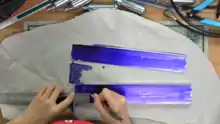Marking blue
Marking blue, layout stain or Prussian blue is a dye used in metalworking to aid in marking out rough parts for further machining. It is sometimes called Dykem (as a generonym dubbed after a popular brand). It is used to stain or paint a metal object with a very thin layer of dye that can be scratched off using a scriber or other sharp instrument to reveal a bright, yet very narrow line in the metal underneath. The advantages are that any existing scratches are covered with the dye and the new lines have a contrasting background.

Marking blue is made by mixing methylated spirits with shellac and gentian violet.[1] This is not to be confused with the non-drying engineer's blue, made by mixing Prussian blue with oil or grease. Despite this, it is sometimes called engineer's blue, which can cause confusion.
Alternatives
A felt tip marker can be used as they are convenient and tend not to dry up as quickly; marking blue in the form of dye or ink has a tendency to dry in the containers and become unusable quickly. On rough structures, such as castings or forgings, whitewash or a mixture of chalk and water can be used. A solution of copper sulfate, distilled water, and a few drops of sulfuric acid can be used on machined surfaces.[1] This thin copper coating is more resistant to rough handling and the action of cutting fluid.
References
- Brink, C.; McNamara, B. (2008), Engineering Fabrication & Boilermaking, Pearson South Africa, p. 44, ISBN 978-1-77025-374-2.